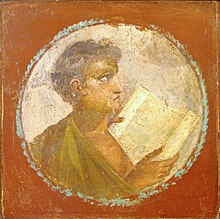Rotulus
Roman portraiture frescos from Pompeii, 1st century AD, depicting two different men wearing laurel wreaths, one holding the rotulus, the other a volumen

A rotulus (plural rotuli) or rotula (pl. rotulae) is a kind of roll consisting of a long and narrow strip of writing material, historically papyrus or parchment, that is wound around a wooden axle or rod and is written on its interior face or side[1] such that it is unwound vertically so that the writing runs parallel to the rod,[2] unlike the other kind of roll, namely the "scroll", whose writing runs perpendicular to the rod in multiple columns.
Rotuli were historically used for:
- Specific legal records in Europe, from which is still derived the title of the judicial functionary denominated the "Master of the Rolls", and the Byzantine Empire;[3]
- Liturgical manuscripts, e.g., those used for chanting the Exultet; and
- Especially mortuary rolls, i.e., documents memorializing the names of all the deceased members of a monastery or other institution, which were banded together and circulated so that they could mutually pray for the repose of each other's decedents.[3]
References
- ^ Grout, James. "Scroll and Codex". Encyclopaedia Romana.
- ^ "What's On?: From Roll to Codex". Bodleian Libraries. University of Oxford.
- ^ a b Daly, Lloyd W. (1973). "Rotuli: Liturgy Rolls and Formal Documents". Greek, Roman and Byzantine Studies. 14 (3). Duke University.
- Attribution
 This article incorporates text from a publication now in the public domain: Herbermann, Charles, ed. (1913). "Rotuli". Catholic Encyclopedia. New York: Robert Appleton Company. The entry cites:
This article incorporates text from a publication now in the public domain: Herbermann, Charles, ed. (1913). "Rotuli". Catholic Encyclopedia. New York: Robert Appleton Company. The entry cites:
- Léopold Victor Delisle, Rouleaux des morts du IX au XV siecle (Paris, 1866);
- ____, in Bibl. de l'ecole des Chartes, series II, vol. III; Sur l'usage de prier pour les morts;
- Thurston, A Mediaeval Mortuary-card in The Month (London, Dec., 1896);
- Nichols in Mem. Archaeolog. Institute (Norwich, 1847);
- Molinier, Obituaires français au moyen-âge (Paris, 1886);
- Ebner, Gebetsverbruderungen (Freiburg, 1891);
- Wattenbach, Schriftwesen im Mittelalter (3rd ed., Leipzig), 150-74.


